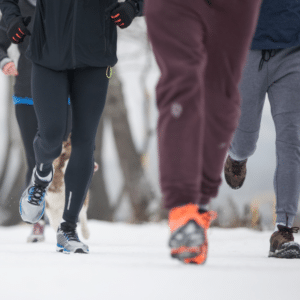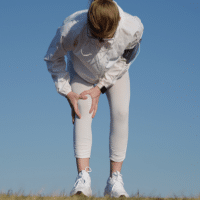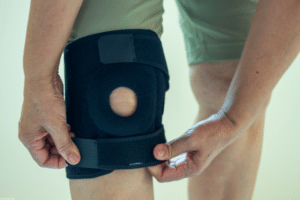Introduction
As the winter chill settles in North America, maintaining a consistent running routine becomes a commendable challenge. Paul Wnuk, a registered physiotherapist at Physio Pros Oakville, sheds light on essential physio tips to keep enthusiasts on track during cold-weather runs.
Winter chill shouldn’t freeze your fitness journey! Staying warm while running in winter is like having a secret plan for sweat. Start with a smart base layer – it pulls sweat away, so you stay dry. Next, add a cozy mid-layer that’s not cotton; it keeps you warm without holding onto moisture. It’s not just about being warm; it’s about being smart and comfy as you conquer the winter run. Sure, it’s cold, but don’t let that stop you from the joy of staying fit and soaking up the outdoors.
Running does wonders for bones, muscles, and that fantastic runner’s high. We get it, though – the snow and cold can be a buzzkill. That’s why we’re sharing Physio Tips for Cold-Weather Footwear, Clothing, and Injury Prevention. Let’s gear up and hit the winter trails without missing out on the fitness and fun!
The Pro Tips for Winter Running
- Footwear Essentials
- Clothing Strategies
- Injury prevention techniques
- Addressing common winter injuries

Footwear Essentials: Winter demands a reevaluation of your running shoe choice. Paul Wnuk emphasizes the significance of traction in icy conditions. Opt for running shoes with reliable treads to prevent slips and falls. Additionally, consider footwear designed for water resistance to keep your feet dry in snow or slush, reducing the risk of cold-related injuries.
Clothing Strategies: Choosing the right clothing is pivotal in warding off the winter chill without compromising mobility. Paul recommends a layered approach. Start with a moisture-wicking base layer to keep sweat away from the skin, followed by an insulating layer for warmth, and finish with a windproof and waterproof outer layer to shield against the elements. Don’t forget to protect your extremities with gloves, a hat, and moisture-wicking socks.
Injury Prevention Techniques: Cold weather increases the risk of muscle tightness and injury. Paul advises incorporating dynamic warm-up exercises before your run to enhance blood flow and flexibility. Focus on key muscle groups, such as quadriceps, hamstrings, and calves. Post-run, static stretching can aid in preventing stiffness and promote muscle recovery.
Addressing Common Winter Injuries: Winter running introduces unique risks, including slips, falls, and exposure to cold-related injuries. Paul Wnuk highlights the importance of listening to your body and adjusting your pace to accommodate icy or uneven terrain. Strengthening exercises targeting the core and lower body can improve stability and reduce the likelihood of injuries.



Winter Running Wellness Guide by Physio Pros Oakville
Tip #1: Mastering Winter Layers
When braving the winter chill, remember this golden rule: running feels about 10°C warmer than the actual temperature. Let’s break it down:
Temperature: 6°C
- Feels Like: 16°C
- Ideal Combo: Long-sleeve shirt, running shorts/tights, winter gloves, and a hat.
Temperature: 12°C
- Feels Like: 22°C
- Ideal Combo: Running shorts, t-shirt. Gloves and hats might take a break.
Temperature: -4°C
- Feels Like: 6°C
- Necessary Gear: Long-sleeve base layer, sweater, base layer tights/thermals, sweats/shorts, winter gloves, hat, and a neck warmer.
Tip #2: Decode Your Shoe Tread
As the mercury drops, your shoe traction becomes crucial. Decode your shoe language:
- Consider traction cleats for an icy grip.
- Opt for trail shoes in milder climates for enhanced traction.
- Regularly check and monitor the tread on your running shoes.
Tip #3: Effort Trumps Pace
Embrace the winter challenge, where changing terrains and layers might slow your pace. Focus on effort:
- Quality runs are best determined by effort level, not pace.
- Adjust to challenging terrains by running based on total time rather than set distances.
Tip #4: Revitalize with Post-Run Recovery
Winter runs demand more from your muscles; ensure a proper cooldown:
- After workouts, prefer static stretching as muscles are warmed up.
- Embrace foam rolling – proven effective in reducing post-exercise muscle soreness.
- Boost circulation and freshness by wearing compression garments for your legs.
The Conclusion
In a nutshell, Winter running isn’t just tough; it’s a chance to change how you run. Don’t shy away from the cold – get the right gear and enjoy the feeling of beating winter. Take care of your muscles after each run – they’ll appreciate it!
Physio Pros Oakville cheers you on to keep running, even when it’s snowy. Stay warm, stay safe, and let winter running be a cool part of your fitness journey. Until your next run, happy trails! ❄️🏃♂️







